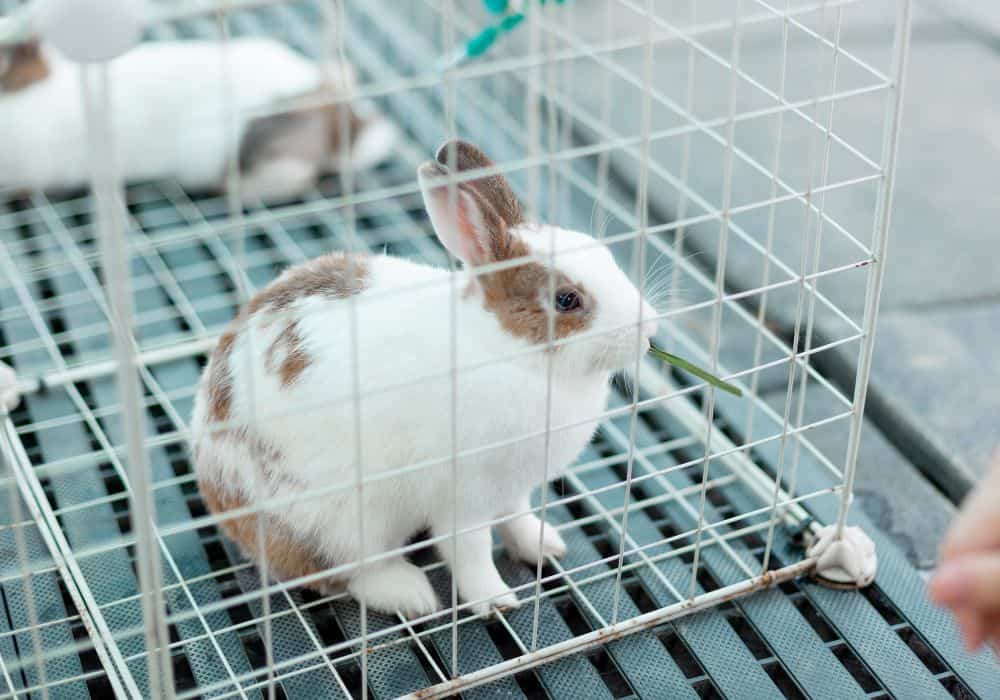In this article, you will learn how to set up a cage for a rabbit and how to choose the right one. Rabbits are one of the most popular small animals kept as pets in the United States. They are relatively low maintenance and can be litter box trained. Rabbits come in a variety of colors and sizes and can be playful and social.
One of the most important aspects of rabbit care is providing them with a safe and comfortable place to live. This is typically done in the form of a rabbit cage. A good rabbit cage should be large enough for the rabbit to move around in, with a place to hide and a place to eat and drink.
When selecting a rabbit cage, it is important to make sure that it is the right size for the rabbit. The cage should be at least four times the size of the rabbit and should have plenty of room to move around.
A good rabbit cage can be a great way to keep your rabbit safe and comfortable and can help to ensure that your rabbit has a long and healthy life.
Technical Characteristics of the Cage for Rabbits
Rabbit cages come in all shapes and sizes, but there are certain features that all good rabbit cages have in common. Here are the technical specifications of an ideal rabbit cage:
- The cage should be at least 24″x24″x18″ in size. Larger cages are better, but this is the minimum size that should be used.
- The cage should have a solid floor. Wire floors are not suitable for rabbits, as they can cause injuries to the feet and legs.
- The cage should have a door that is big enough for the rabbit to comfortably get in and out of.
- Ideal if the cage will have two levels or more. This gives the rabbit more space to move around and explore.
- The cage should be made of sturdy materials. Wire cage sides are fine, but the floor and door should be solid.
- The cage should be easy to clean. A removable floor and door are both helpful in this regard.
- The cage should be placed in an area that is out of direct sunlight and away from drafts.
- The cage should be equipped with a water bottle and a food dish.
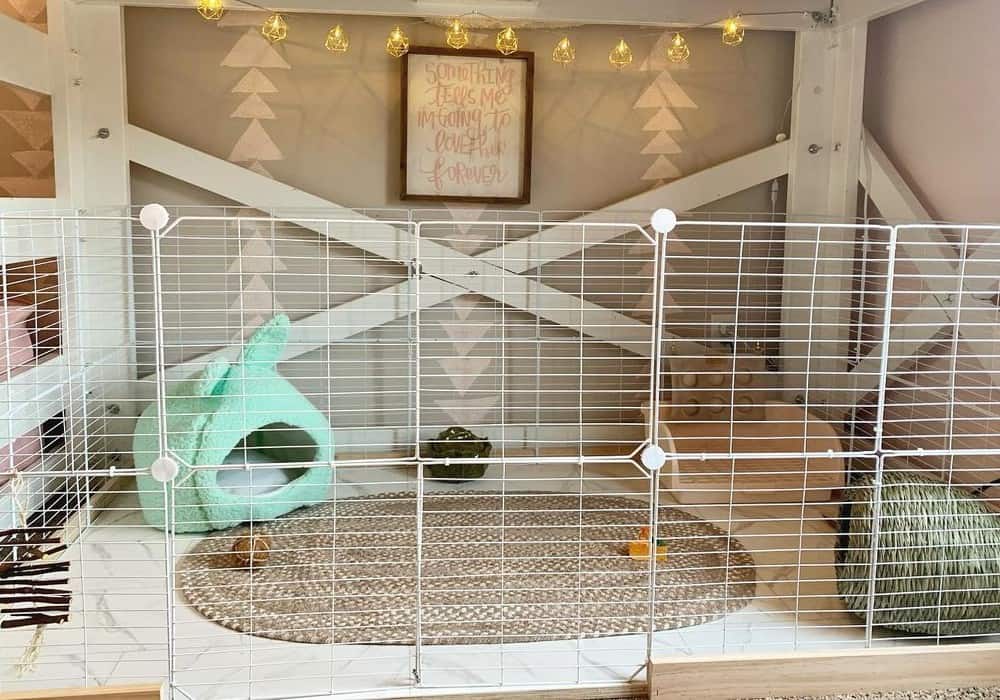
What Size Rabbit Cage Should I Buy?
When it comes to deciding what size rabbit cage to buy, there are a few things you’ll need to take into account. For starters, how many rabbits will be living in the cage? If you’re planning on housing multiple rabbits, you’ll obviously need a larger cage than if you’re only planning on keeping one.
Another thing to consider is the amount of space your rabbits will need to roam and explore. Obviously, the more space they have, the happier they’ll be. But that doesn’t mean you need to go out and buy the biggest cage possible – just make sure there’s enough room for them to move around and stretch their legs a bit.
Finally, think about where you’ll be placing the cage. If you have limited space in your home, you might need to opt for a smaller cage. But if you have a large backyard or some extra space in your house, you can definitely go for a bigger cage.
Cage Materials
There are many different types of rabbit cages on the market, but not all of them are made with the proper materials. A rabbit cage should be made out of sturdy, non-toxic materials that will not harm your rabbit if they chew on it.
The most common type of rabbit cage is made out of wire. Wire cages are strong and durable, but they can also be dangerous for your rabbit if they are not made with non-toxic materials. If you choose a wire cage for your rabbit, make sure that the wire is coated in a safe, non-toxic material.
Another popular type of rabbit cage is made out of plastic. Plastic cages are often less expensive than wire cages, but they are not as durable. If you choose a plastic cage for your rabbit, make sure that it is made out of thick, sturdy plastic that will not easily break.

Exercise Area
Rabbits are natural athletes. In the wild, they run and jump for hours every day. When they are confined to a cage, they still need to exercise to stay healthy.
The exercise zone is the part of the cage where the rabbit can run and jump. It should be at least four times the size of the rabbit. The exercise zone should be filled with toys and obstacles for the rabbit to play with.
Rabbits need to exercise every day to stay healthy. A healthy rabbit will have a strong heart and lungs, strong muscles, and healthy bones. Exercise also helps rabbits stay agile and quick.
Rabbits that don’t exercise enough can become obese, and their health will suffer. They may also become lazy and inactive.
Location
If you’re looking for the best place to put your rabbit cage, there are a few things to keep in mind.
First, your rabbit should have plenty of room to move around and exercise. A good rule of thumb is to provide at least 4 square feet of space per rabbit.
Secondly, the cage should be placed in an area where your rabbit can see and interact with you and other family members. This will help your rabbit feel like part of the family.
Finally, make sure the cage is placed in a safe location away from any potential hazards, such as electrical cords or poisonous plants.
By following these guidelines, you’ll be sure to provide your rabbit with a happy and healthy home.
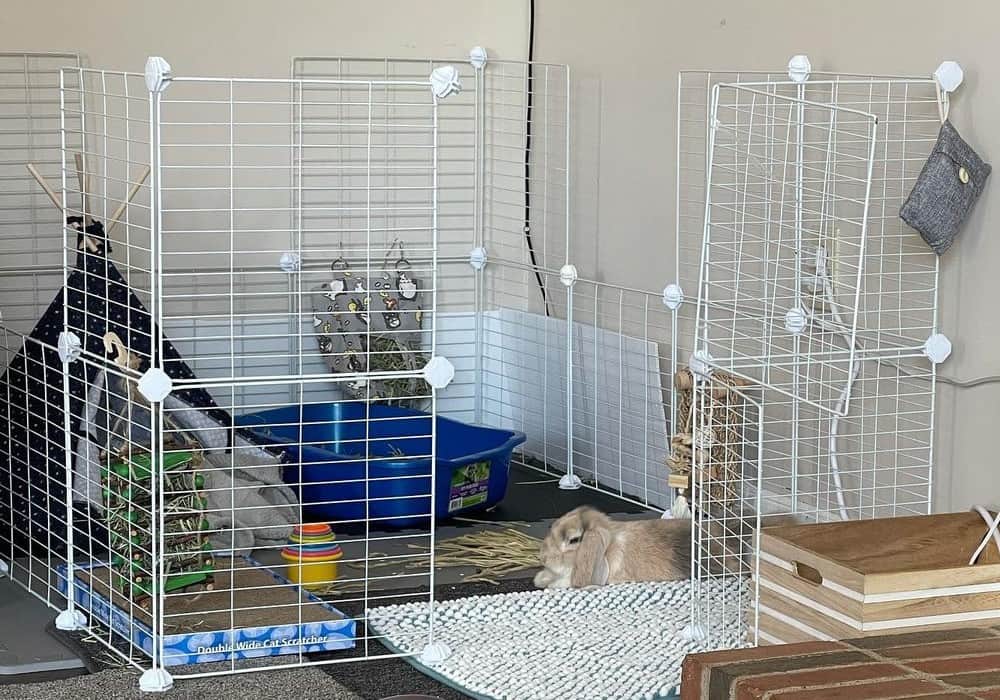
Do You Need Two Rabbit Cages for a Private House
If you are planning on keeping rabbits as pets in your home, you may be wondering if you need two rabbit cages. The answer to this question depends on a few factors, such as whether you plan on keeping the rabbits together or separately, and whether you have the space for two cages.
If you want to keep the rabbits together, then you will need two cages. This is because rabbits are social animals and need to live in pairs or groups in order to be happy and healthy. Two cages will also give the rabbits more space to exercise and explore.
If you do not have the space for two cages, or if you plan on keeping the rabbits separate, then you will only need one cage. However, you should make sure that the cage is large enough for the rabbit to have plenty of room to exercise and move around.
In general, it is best to have two rabbit cages, especially if you plan on keeping the rabbits together.
Indoor Rabbit Cage vs Outdoor Rabbit Cage
One of the most important decisions you will make when owning a rabbit is whether to keep it indoors or outdoors. Each option has its own set of pros and cons that you should consider before making a decision.
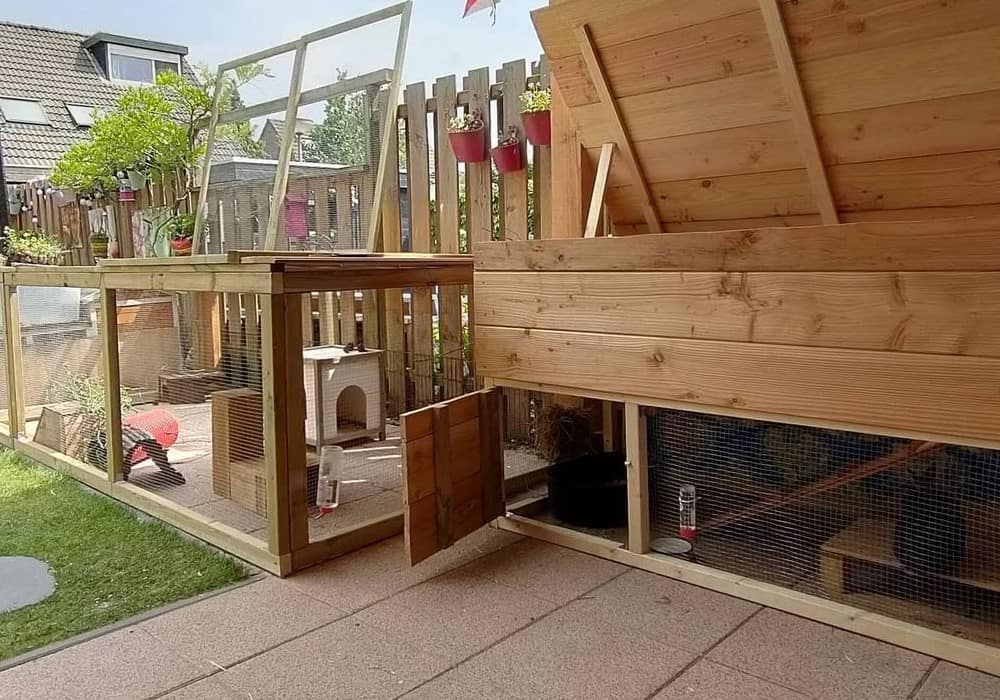
Outdoor Rabbit Cages
Outdoor rabbit cages have the advantage of being larger and more spacious than indoor cages. This gives your rabbit plenty of room to run and play. It also allows them to get fresh air and sunshine, which can be beneficial for their health.
However, there are also some drawbacks to outdoor rabbit cages. The main one is that they are exposed to the elements. This means that your rabbit could be at risk of exposure to bad weather, predators, and other dangers. If you live in an area with a lot of predators, it is probably not safe to keep your rabbit outdoors.
Indoor Rabbit Cages
Indoor rabbit cages have the advantage of being more secure than outdoor cages. This means that your rabbit will be protected from predators and bad weather. Indoor cages also give you more control over the environment, which can be beneficial if your rabbit has health problems.
However, there are also some drawbacks to indoor rabbit cages. The main one is that they can be smaller and more cramped than outdoor cages. This can make your rabbit feel stressed and unhappy. If you have the space, it is probably better to go for an outdoor cage.
So, which is better? Outdoor or indoor rabbit cages? The answer depends on your individual circumstances. If you have the space and live in a safe area, an outdoor cage is probably the best option. However, if you are worried about predators or bad weather, an indoor cage is probably the better choice.
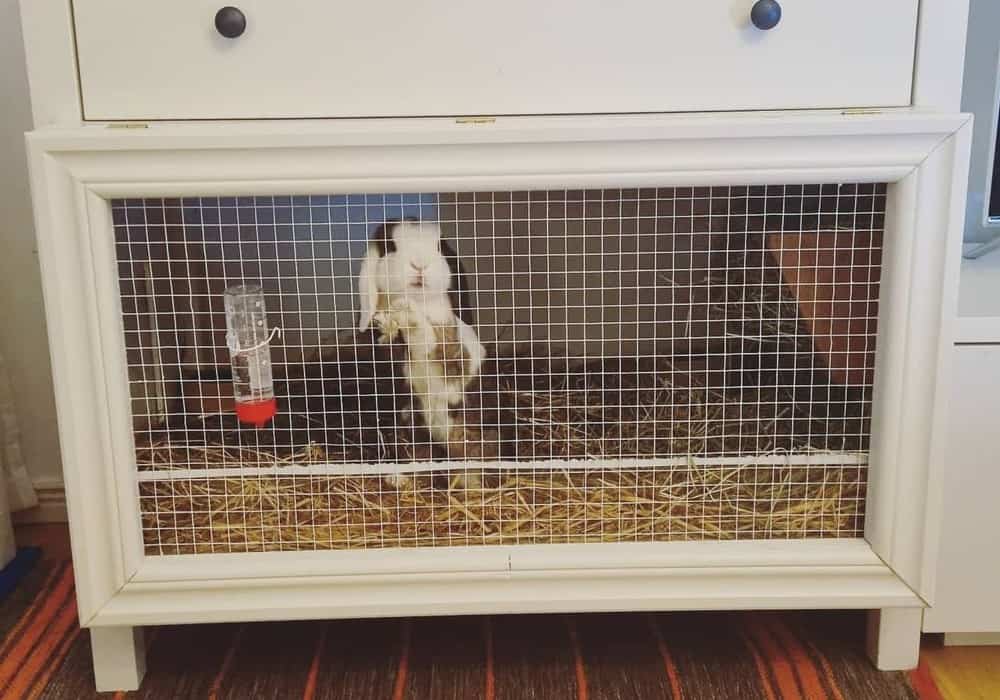
How to Set up a Rabbit Cage
Below you will learn how to set up a rabbit cage indoors:
You will need:
- A cage is big enough for your rabbit to move around comfortably;
- A water bottle;
- A hay feeder;
- A food bowl;
- Chew toys.
- Start by finding a cage that is big enough for your rabbit to move around in comfortably. The general rule is that a cage should be at least four times the size of your rabbit.
- Place a water bottle in the cage. Make sure the water bottle is secure so that it cannot tip over.
- Place a hay feeder in the cage. This will be where your rabbit can access hay.
- Place a food bowl in the cage. This will be where your rabbit can access its food.
- Lastly, add some chew toys to the cage. This will help keep your rabbit entertained and help with its dental health.
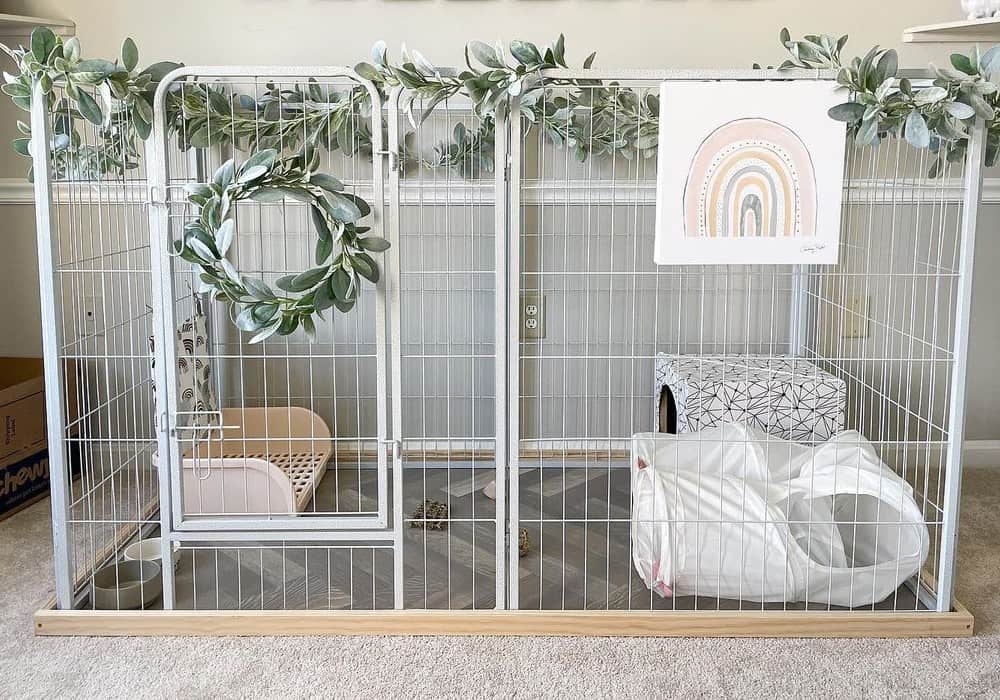
How to Set Up My Rabbit Cage With a Wire
So, how to set up a rabbit’s cage with a wire? If you’re looking to house your rabbit indoors, you’ll need a wire cage. Wire cages are strong, and durable, and provide plenty of air circulation, which is important for your rabbit’s health. They also allow your rabbit to see what’s going on around them, which helps to keep them stimulated. Follow these steps for indoor rabbit cage setup.
- Choose a suitable location for the cage. It should be in a quiet area away from direct sunlight or drafts.
- Place a layer of absorbent material, such as newspaper, in the bottom of the cage.
- Add a layer of hay or straw over the absorbent material. This will provide your rabbit with a comfortable place to rest.
- Place a water bottle and food dish in the cage.
- Place a litter box in the cage. Rabbits like to bury their droppings, so choose a litter that your rabbit can easily dig in.
- Add some toys and hiding places to the cage to keep your rabbit entertained.
- Once you’ve set up the cage, introduce your rabbit to its new home. Allow them to explore the cage at their own pace.
What Should Be Put in the Rabbit Cage?
You learned how to set up a bunny cage, but what should you put inside the cage? In terms of things to put inside the cage, water and food are obviously key. Your rabbit should have a water bottle or bowl that’s easily accessible, and you should refill it daily.
For food, hay should make up the majority of your rabbit’s diet, and you can supplement it with fresh vegetables and a small number of pellets. You should also include a litter box in your rabbit’s cage, and fill it with a soft, absorbent material like newspaper or wood shavings.
Finally, you should make sure your rabbit has plenty of toys and things to keep them occupied. This could include anything from chew toys to a cardboard box to hide in. By providing your rabbit with a stimulating environment, you can help them stay healthy and happy.
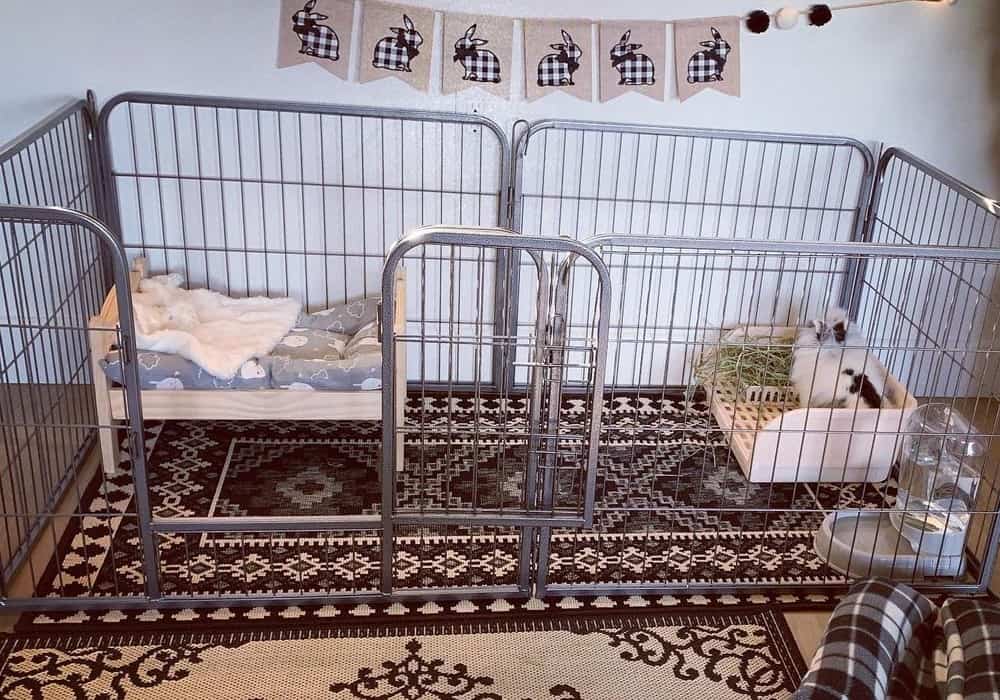
Cleaning the Rabbit Cage
As often as possible, the entire cage should be emptied and scrubbed with a disinfectant solution. The wire bottom should be removed and scrubbed separately. The rabbit should be removed from the cage and given a chance to exercise in a safe area. The cage should be rinsed thoroughly and allowed to dry before the rabbit is returned to it.
Rabbits are very clean animals and will groom themselves extensively. However, their cage still needs to be cleaned on a regular basis to prevent the build-up of bacteria and odors. The frequency of cleaning will depend on the size of the cage and the number of rabbits. For a small cage housing one or two rabbits, it should be cleaned at least once a week. For a larger cage housing multiple rabbits, it should be cleaned at least twice a week.
When cleaning the cage it is important to use a mild special disinfectant solution and avoid harsh chemicals.
FAQ
Do Rabbits Need a Tray in the Cage?
Rabbits need a tray in their cage to protect the floor underneath from getting wet or dirty. It also helps to keep the rabbit’s fur clean and dry.
What Should I Look for When Choosing a Rabbit Cage?
There are a few things you should look for when choosing a rabbit cage. The cage should be made of a durable material that will not rust or break easily. It should also be large enough for your rabbit to move around freely and have plenty of room to play. The cage should also have a bottom that is easy to clean and a top that is easy to access.
Do I Need to Change the Rabbit Cage as the Rabbit Grows?
Yes, you will need to change the rabbit cage as the rabbit grows. A baby rabbit will need a smaller cage than an adult rabbit.
Conclusion
In this article, you learned how to set up a rabbit cage inside. When you bring a new rabbit home, one of the first things you will need is a rabbit cage. The cage should be big enough for the rabbit to move around in and should have a place for the rabbit to hide. The cage should also have a place for the rabbit to eat and drink.
No matter what type of rabbit cage you choose, be sure to keep it clean. Rabbits can get sick if they live in a dirty cage.
References:
- Poisonous Plants for Rabbits (HOUSE RABBIT SOCIETY): http://www.allearssac.org/pdf/poison.pdf
- Rabbit Dental Care (PetMD): https://www.petmd.com/rabbit/general-health/rabbit-dental-care-101
- Feeding Your Rabbit (VCA ANIMAL HOSPITALS): https://vcahospitals.com/know-your-pet/feeding-your-rabbit
Also read:
- Discover the Amazing World of 10 Day Old Bunnies: All About Rabbits!
- Discover All About the Characteristics of a 1 Year Old Rabbit
- Why Doesn’t My Rabbit Like Me? – Understanding Rabbit Behavior for All About Rabbits
- Everything You Need to Know About Bunny Grinding Teeth in Rabbits
- How Eating Poop is Part of a Normal Rabbit Diet – All About Rabbits
